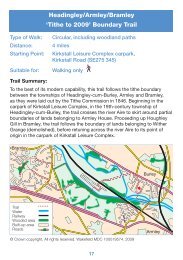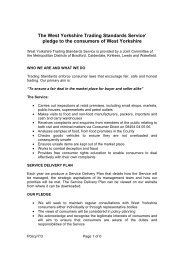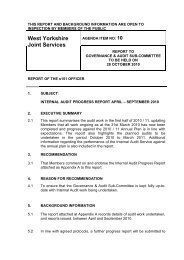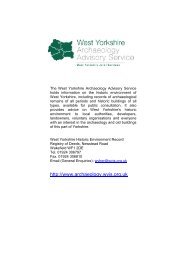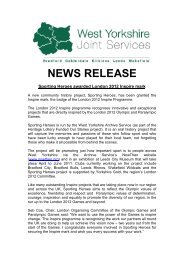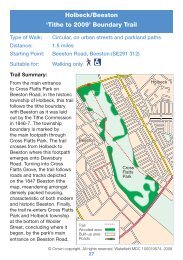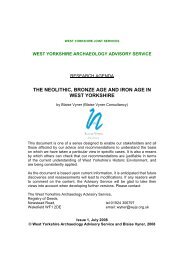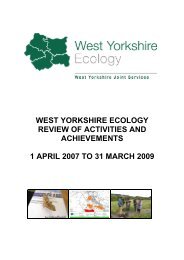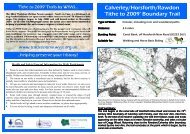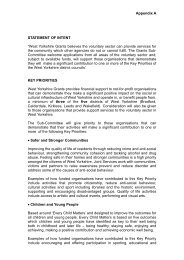Collections Guide - West Yorkshire Joint Services
Collections Guide - West Yorkshire Joint Services
Collections Guide - West Yorkshire Joint Services
You also want an ePaper? Increase the reach of your titles
YUMPU automatically turns print PDFs into web optimized ePapers that Google loves.
(WT:26) [c1918] Printed invitation from Sir Frederick Whitley Whitley-Thomsonto view the procession in celebration of peace from 65 Sloane St, London. Withphotograph of the houseFrederick Whitley Thomson was born in Glasgow on 2 September 1851, the son of Jonathan Thomson ofGlasgow, merchant and Emma Whitley (born 26 January 1825, married Square Chapel 11 October 1850),granddaughter of John Whiteley, founder of the firm of John Whiteley and Sons, and daughter of John andSusanna Whitley (nee Whiteley). They had two other sons (Reginald, Arthur who both died young) and threedaughters, Louisa, Emma and Augusta, who were all given the name Whitley as a second Christian name.Frederick was educated at the Glasgow Academy and the Andersonian University College, Glasgow. He firstcame to Halifax in 1869 to learn cotton spinning with his uncle, Samuel Whitley, who occupied Hanson LaneMills. After a brief return to Glasgow, he came back to Halifax in 1879 to join the business of his otheruncles, John and Nathan Whitley at John Whiteley and Sons of Brunswick Mills, as a traveller. He eventuallybecame Head of the Firm, and with his cousin Alfred William Whitley he made it a private limited companyand then led it into merger with the English Card Clothing Company Limited in 1897, where he remained aDirector. He was Mayor of Halifax from 1908-1911, and he was also Vice-President of the Halifax MechanicsInstitute and Chairman of the Halifax Technical School. He was Liberal MP for the Skipton Division from1900-1906, when he resigned because of health problems. In 1908 and 1911 he contested SouthHerefordshire and Colchester but was unsuccessful in his attempts to re-enter the House of Commons. Hetravelled extensively and was a strong advocate of the teaching of foreign languages as an aid to commerce.In 1908 he became the chief magistrate of the Borough of Halifax, remaining in office for 3 years. He wasnot a member of the Council when he was invited to become Mayor in 1908, but a seat was found for him inSkircoat Ward. After retiring from the mayoralty in 1911, he continued his membership of the Council and in1913 succeeded Sir George Fisher-Smith as Chairman of the Finance Committee until 1919. He lived atSavile Heath and was a member and deacon of Park Congregational Church. He later principally lived inLondon, first at 65 Sloane Street and later from 1919 at 19 Addison Rd, Kensington. On 10 August 1914 hewas granted the right to take the name Whitley in addition to and before that of Thomson and to bear thearms of Whitley quarterly with those of Thomson. Arms for his paternal name of Thomson were granted on 9June 1915 and the same patent gave him an impalement for Smith. By another patent dated the followingday, he was granted arms representing his Whitley descent. In 1916 he was created a Knight Bachelor. Hedied at St Leonard's-on-Sea on 21 June 1925, aged 74. He was buried in the Thomson family vault inGlasgow. He left a large estate. He married on 29 August 1888 at Sion Chapel, Halifax, Bertha FlorenceSmith, daughter of Matthew Smith, Mayor of Halifax. She outlived her husband, dying at Harrogate on 18May 1943, aged 81. They had one daughter, Doris, born 1 April 1862, who became the wife of LieutenantCommander Joseph Montague Kenworthy, MP on 4 December 1913. He became the 10th Baron deStrabolgi in 1933. There is a distinct link with textiles that accounts for the considerable wire manufacture inthe Halifax area. The carding of fibres either by hand or the carding engine requires wire to be set in thecards; wire is also used to separate warp threads in looms. Wire manufacturers frequently went on tobecome card manufacturers also and sometimes tanners too. John Whiteley and Son was one of the earliestmanufacturers of wire for cards, established in 1791 by John Whiteley, born 1758, when cards were madeentirely by hand. They had premises in Winding Rd by 1822. In the 1840s they moved to Brunswick Mills,<strong>West</strong> Parade, worsted mills established by Thomas Smith Scarborough and his brothers. In 1863 they werevisited by the Prince of Wales. By the 1890s they employed 300 work people and they went on to have



